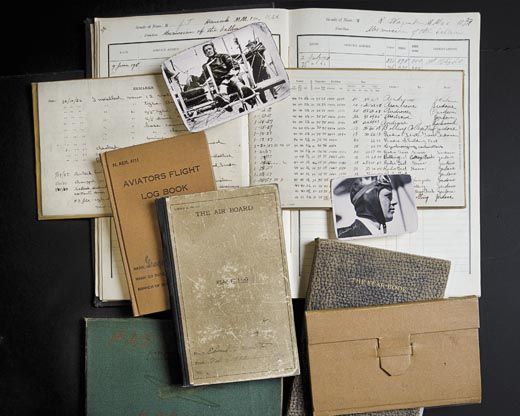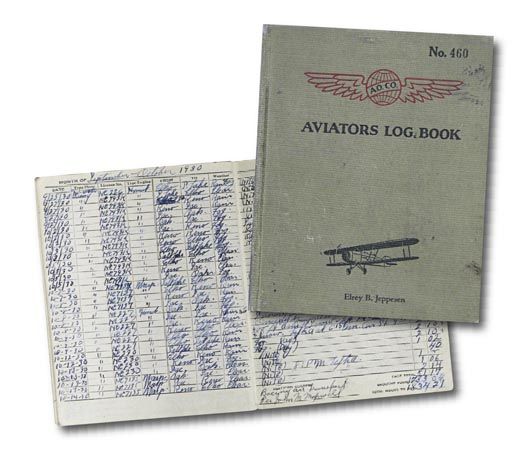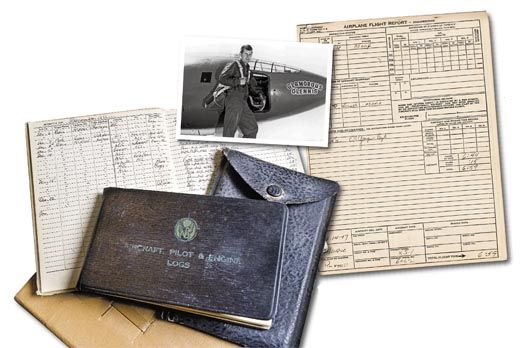The Book of Hours
A peek into the logbooks of history’s notable pilots.
/https://tf-cmsv2-smithsonianmag-media.s3.amazonaws.com/filer/Arch_Logbook_Flash_ON09.jpg)
On December 23, 1986, after more than nine days of dodging storms, battling fatigue, troubleshooting mechanical problems, and worrying whether he and copilot Jeana Yeager would have enough fuel to make it home, pilot Dick Rutan gently guided the twin-engine Voyager onto the runway at Edwards Air Force Base in California. They had just completed the first nonstop flight around the globe without refueling, and thousands of well-wishers were on hand to cheer their accomplishment. After shutting down the engines and securing the aircraft, Rutan had one more thing to do before he could take his first shower in more than a week. Handed a slender, rectangular book, Rutan opened it and began filling in the blocks across the double-page spread.
Date: “Dec. 14–23.”
Aircraft Make and Model: “Voyager.”
Total Duration of Flight: “216.3.”
And so on. In a small space reserved for “Remarks,” Rutan wrote: “World Flight.” He then added a little flourish: a smiley face.
Flight logs have been around as long as aviation itself. The Wright brothers kept detailed notebooks, recording dispassionately the results of their experiments in building the first airplane. After his landmark flight on December 17, 1903, Orville wrote: “The machine lifted from the truck just as it was entering on the fourth rail. Mr. Daniels took a picture just as it left the tracks.”
Nine years later, pilots of Britain’s Royal Flying Corps (the precursor to the Royal Air Force) were using logbooks routinely. Unlike the free-form pages the Wrights used, the new books’ pages were divided into rows and columns, their format borrowed from ship’s logs, which had been in use for more than a century. In a logbook from 1913, a pilot penned on one page the date of a flight, airplane used, passenger’s name, time aloft, and course flown. On the opposite page, he recorded height achieved, distance, weather, and remarks. The entries show the limitations of the technology. The airplanes were slow, unreliable, and capable of carrying only light loads (thus the singular “passenger”) and flying only short lengths (thus “course” and “distance,” versus “route” and “destination”). In 1913, there were no stamps or endorsements indicating that such logs were mandated by higher-ups. The purpose of the logs was to document the capability of the aircraft as much as that of the pilot. At this point in aviation history, all pilots were essentially test pilots.
Logbooks also became an important component of civil aviation. In the United States, barnstormers, airline pilots, and airmail carriers all kept logs, in many cases simply to make sure they were properly paid. The Air Commerce Act of 1926, which set forth the first regulations governing the certification of aircraft and licensing of pilots, also made flight logs a requirement. In addition to setting down the rules and basic format of a pilot’s log, the act required logbooks to be regularly certified. The law also mandated logs recording the maintenance of individual aircraft. Before this, maintaining aircraft generally fell to the pilots who flew them. But as the technology became more complex and maintenance became more specialized, logs were deemed necessary to document an individual aircraft’s mechanical history and airworthiness.
The Civil Aeronautics Administration in 1940 relaxed the rules governing pilots’ logs. The new rules mandated that pilots keep only a “record of the flight time used to substantiate recent experience or qualifications for certification or ratings.” No verification was necessary; when it came to logging most of their flight hours, pilots were on an honor system. Airlines considering a new hire first looked at a pilot’s total hours, generally requiring a minimum of around 1,500, so the rules became an invitation to lie. The practice of padding a logbook with “P-51 time” (so-called for a popular pen, the Parker 51) became a well-known, if seldom admitted, practice. Though the consequences of getting caught are serious (falsifying a pilot’s log is a federal offense), “it probably happens more than you realize,” says Barry Schiff, a retired TWA pilot and aviation writer. In most cases, he says, the culprits are never caught unless an incident prompts a closer look. Investigators can sometimes check the accuracy of a log by cross-referencing it with records kept by insurance companies, airport operators, and air traffic control.
Many professional pilots cease recording their hours as soon as they get their pilot’s rating. “There’s no reason,” says retired Air Force colonel Leonard L. Griggs, who quit keeping a pilot’s log soon after getting his wings in the early 1960s. A pilot in Vietnam who went on to a career at the Federal Aviation Administration and a job as head of Lambert-St. Louis International Airport in Missouri, Griggs says he let his bosses track his cockpit hours. Keeping a logbook, he says, was a useless chore. Besides, “nobody corroborates them. It’s like reporting your golf score.”
Nevertheless, says Schiff, most pilots do maintain a personal log, often simply as a habit from their student pilot days. The books also become a kind of diary. “Flying has been the centerpiece of my life since I was 14,” says Schiff. “My first logbook begins in 1952, and I wouldn’t [risk taking] it anywhere. It’s a treasure.”
Though most pilots stick with the standard flight log, a few get creative, squeezing in expanded descriptions of a particular flight or even building elaborate scrapbooks to document their flying histories. “I’ve run into some international pilots who pasted into their logbooks stamps or coins from every country they visited,” says Schiff. Whether they detail a single flight, an entire career, or even the history of an individual airplane, logbooks are a part of the history and culture of flying.
Benjamin Foulois
Lieutenant Benjamin D. Foulois, a pilot with the U.S. Army Signal Corps, documented his test flights of the U.S. Army’s only airplane in 1909 (a Wright Model B) in a thin, leather-bound notebook labeled “Log—Airplane No. 1.” The March 12, 1910 entry reads:
“Made 5 perfect flights, lasting 8 min 25 sec, 15 [min] 10 sec, 4 min 10 sec, 12 min 10 sec, & 16 min respectively. During the 4th flight Lt. Foulois made a large detour of about 1 mile from the aero field, circling the building at the Lower Post. The machine was under perfect control at all times and landings were excellent.”
The handwritten log covers February 1910 to July 1911, records Foulois’ trials in getting the airplane assembled and ready for flight, and describes the details of his 64 flights, as well as his many frustrations with weather delays, breakdowns, and frequent mishaps. Total time in the air: Nine hours and 10 minutes. Foulois’ tests went a long way in convincing the Signal Corps and Congress of the need to develop an aviation industry. Foulois went on to become a major general and chief of the Army Air Corps from 1931 to 1935.
Charles Lindbergh
Immediately after Charles Lindbergh landed outside Paris on May 21, 1927, having made the first nonstop transatlantic solo flight, his airplane was swarmed. “Within seconds my open windows were blocked with faces,” he wrote in his 1953 memoir of the flight, The Spirit of St. Louis. “I could feel the Spirit of St. Louis tremble with the pressure of the crowd.” As Lindbergh was pulled from the cockpit and lifted above the mob at Le Bourget airfield, he “heard the crack of wood...and there was the sound of tearing fabric.” He was afraid—not for himself, but for his airplane.
Carried to safety, Lindbergh later learned that someone had stolen, among other things, his logbook. It was never recovered. “That was a devastating thing for him,” says Erik Lindbergh, Lindbergh’s grandson. To write his memoir, Lindbergh had to re-create the flight from memory. “You know, memory is a funny thing,” says Erik. “After spending 33 hours in a plane, it would be hard just to recall all the parts of the flight.” The loss was a personal one for Lindbergh, and even greater for aviation history.
Elrey Jeppesen
The year was 1930. Twenty-three-year-old pilot Elrey Jeppesen had just been hired by Boeing Air Transport (later to become United Air Lines) to fly the mail between stops in Nevada, Utah, Nebraska, and Wyoming at a rate of $50 per week plus 14 cents per mile. With only Rand McNally road maps, airmail pilots navigated by flying low enough to follow such landmarks as roads, rivers, and railroad tracks. Pressure to deliver the mail on time, no matter the weather, forced pilots to fly in extremely dangerous conditions. That first winter, four of the 18 pilots flying the mail on Boeing’s western routes were killed (see “Airmail Odyssey: 1918–2008” at www.airspacemag.com).
Jeppesen started taking notes on the routes. In a small, black, looseleaf notebook, he recorded field lengths, slopes, drainage patterns, and details on lights and obstacles. He also included drawings of terrain and airport layouts and of the location of pastures he could use in an emergency, along with the phone numbers of sheriffs and ranchers who could provide weather reports. Jeppesen’s fellow airmail pilots soon noticed that while they were stuck on the ground waiting out the weather, Jeppesen was somehow getting through. They started asking him if they could get a copy of his notes. After enough requests, Jeppesen recognized a business opportunity, and in 1934, he started selling copies for $10 apiece, beginning an aviation chart business that now brings in $120 million a year.
“I didn’t really think much about a system or publishing it,” Jeppesen said in a 1992 interview with IFR magazine. “I really did it just to save my own hide.”
Chuck Yeager
For years, the sound barrier had been considered a wall that could not be penetrated. Breaking it, wrote U.S. Air Force test pilot Chuck Yeager in his 1986 autobiography Yeager, would be a leap into the “Ughknown.” What would happen when he tried to make that leap in the rocket-powered Bell X-1? Would the aircraft shake so violently it would break apart?
Yeager made a series of flights in which he nudged the X-1 closer and closer to the barrier. On October 14, 1947, he was ready to attempt to push past Mach 1. At more than 20,000 feet, he and the X-1 dropped from a Boeing B-29 mothership. After stabilizing his aircraft, Yeager activated the four-chamber rocket engine and the X-1 shot upward. At 36,000 feet, he cut two of the rocket chambers. Leveling off at 42,000 feet, he fired another chamber and the X-1 surged to .96 Mach, then .965. As the aircraft increased in speed, the ride smoothed out. “Grandma could be sitting up there sipping lemonade,” Yeager wrote in his autobiography. Far below in the desert valley, a sonic boom confirmed that he had indeed broken the sound barrier, and it was later calculated that Yeager had reached Mach 1.06.
After the history-making flight, Yeager updated his logbook with a succinct entry: “ok.”
James Edgerton
On March 1, 1918, prodded in part by the banking industry, which wanted to cut the “float” time for checks sent from one city to another, Congress appropriated $100,000 to start airmail service between New York, Philadelphia, and Washington, D.C., with U.S. Army pilots and airplanes doing the flying.
Things got off to a rocky start when the pilot flying the inaugural run from Washington, D.C., to Philadelphia on May 15 got lost in a fog and crash-landed in a Maryland pasture. The crash delayed the departure of Lieutenant James C. Edgerton, assigned to the first flight of the Philadelphia-Washington, D.C. leg. According to Edgerton’s logbook, he flew a Curtiss Jenny trainer, taking off at 1:14 that afternoon from Bustleton Field and arriving
in Washington, D.C., at 2:50 p.m. The Jenny, he noted in his log, has a “tendency to fly to left and [be] a little nose heavy,” and because “too much oil” had been put into the engine, “during the first hour of flight” oil was flung over both airplane and pilot. Other than that mess, the flight was uneventful.
According to his logbook, Edgerton made 52 airmail trips for a total of 7,155 miles, with only one forced landing.
Tom LeCompte is a pilot and freelance writer who lives near Boston.


